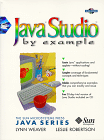Logic Programming or Hyper-RAD
Hands-on exploration of a surprisingly accessible and innovative programing environment.
ORIGINAL DRAFT
When Sun released their Java Studio development environment, they introduced a radical change in perspective to many programmers. RAD (Rapid Application Development) tools typically provide a visual environment for developing forms, dialogs and window layouts, but the Java Studio takes another huge leap toward visual programming. In fact, developers who use this approach never actually see any code. The environment is easy to use and surprisingly productive when properly applied. "Java Studio by Example" guides the reader through the necessary learning curve, resulting in a productive experience that allows them to move quickly on to bigger projects.
Java Studio is clearly not for everyone. It hides the code completely and seasoned developers do not like this restriction. The output from Java Studio is a set of class files and the intermediate source code is simply not accessible in any form whatsoever. On the other hand, even a non-programmer can learn to create useful programs with this environment and the collection of reusable elements provided with the Java studio reveals a great many patterns that give us additional insights into the way software can be put together. In addition, JavaBeans and easily be imported to extend the basic element set.
This book is designed to help non-programmers become productive with the Java Studio. It covers the user model and what it takes to go from design to finished program. Part I lays the foundation, covering the various views and component palettes. Part II provides a number of practical examples to learn from, including an Information Form Applet, a Map and Stopwatch applet, Animation, Arithmetic and Logic applets, and a Database application. These examples demonstrate the power of Java Studio, making complex programming tasks achievable for even the non-programmer.
Since most readers of this review probably do not qualify as novice programmers, this book may not directly appeal to you. I recommend it for two reasons, however. First, the patterns captured by this visual development environment provides insights you might not find any other way. This is not enough of a reason to make a purchase for most, so the second reason is more compelling. Many Internet organizations are dealing with a broad spectrum these days, raging from programmatically intensive application code to visual content on the web. Java Studio provides a means to bridge the content-developer/programmer gap, by allowing web publishers to develop applets or other application code from JavaBeans components which may be developed by the more experienced programming group. If this describes the way your organization is divided, you may want to check this out. In either case, Java Studio by Example is the best available book on the subject and does a great job of presenting information in a format which is easy to apply in the real world.
